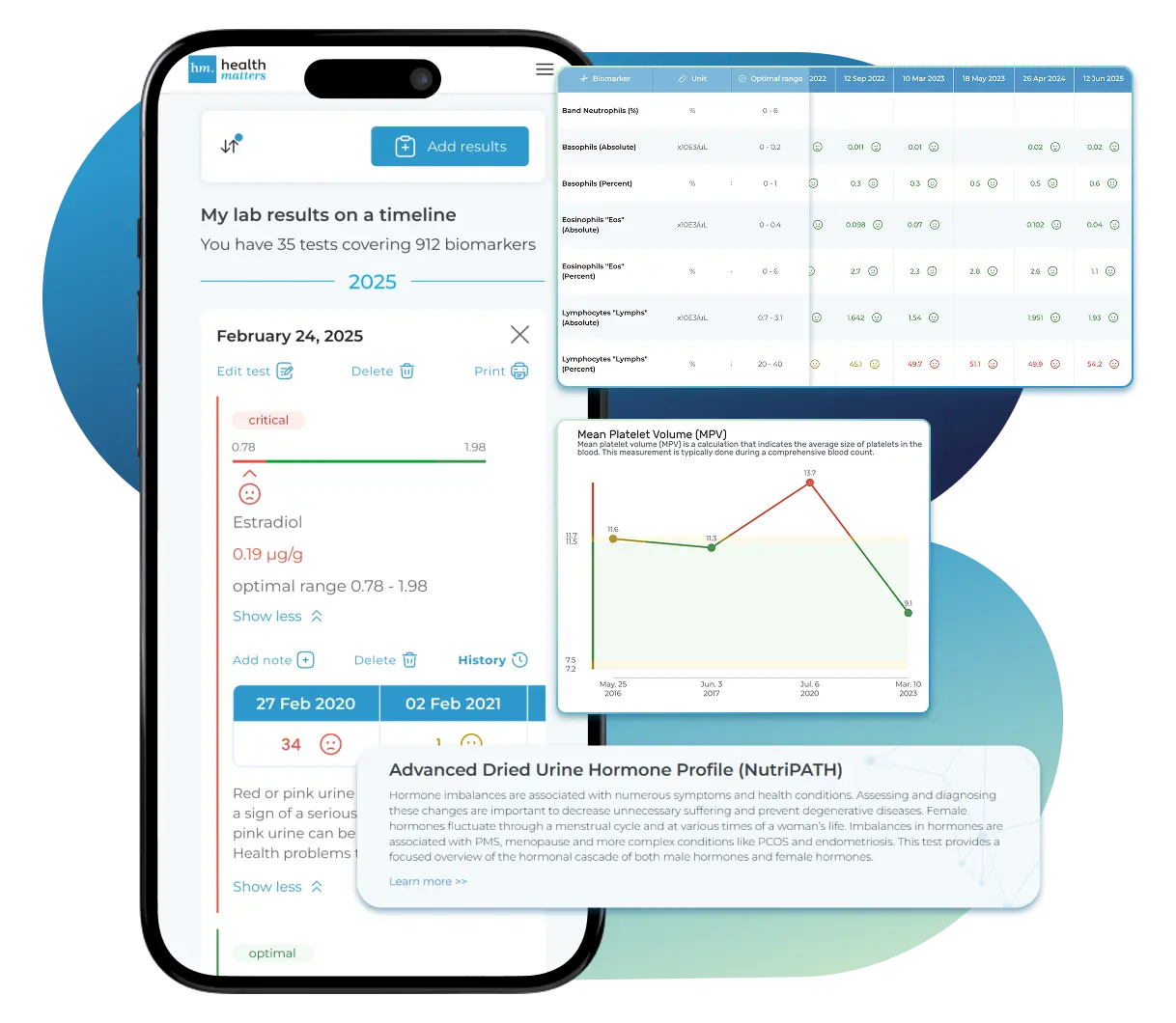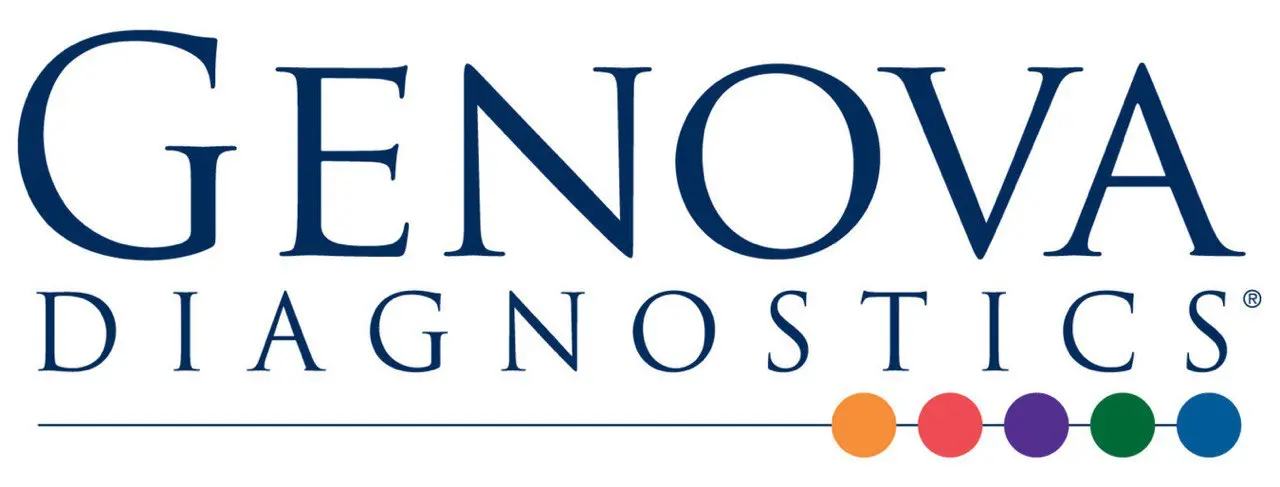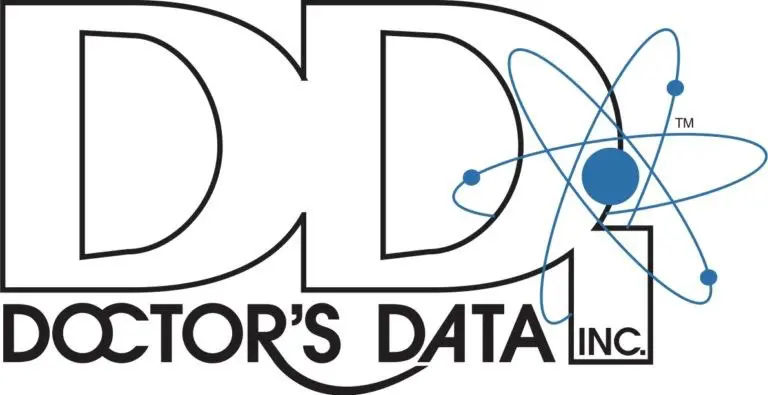Other names: BUN/Creat Ratio
Updated: Aug 13, 2025
High Ratio (>20:1): May indicate dehydration, reduced kidney blood flow, or upper GI bleeding.
Low Ratio (<10:1): May indicate liver disease, malnutrition, or muscle breakdown.
The BUN/Creatinine ratio compares the amount of Blood Urea Nitrogen (BUN) to creatinine in your blood.
It is an important tool for assessing kidney function, hydration status, and potential causes of abnormal lab results.
BUN is a waste product from the breakdown of protein.
Creatinine is a waste product from muscle metabolism.
Both are filtered by the kidneys and removed through urine.
Normal range: In most adults, 10:1 to 20:1 is considered normal, though some labs extend the upper limit to 24:1.
Learn about high BUN/Creatinine ratio and Learn about low BUN/Creatinine ratio
Why this test matters:
By looking at the ratio rather than each marker alone, healthcare providers can better determine if kidney issues are due to dehydration, reduced blood flow, or direct kidney damage, and guide further investigation or treatment.
The Blood urea nitrogen (BUN): Creatinine Ratio [BUN/Creatinine Ratio] is a renal (related to kidneys) function indicator, commonly used to diagnose acute or chronic renal (kidney) disease or damage.
Blood Urea Nitrogen (BUN) and creatinine are both waste products of normal metabolism in the human body.
BUN represents the amount of nitrogen produced from the metabolism of proteins.
Creatinine is a normal waste product of muscle.
Once a person performs both a BUN and Creatinine test, doctors can use the combined results to find the BUN-to-creatinine ratio. The BUN and creatinine tests alone are excellent methods of testing liver and kidney health, but together, doctors get a much better understanding of your kidney health and can provide a more accurate diagnosis to kidney-related issues.
Most clinicians agree that creatinine is a more specific indicator of glomerular function than BUN. However, the BUN to creatinine ratio may be used as an indirect estimate of renal function.
Note: If results for BUN and Creatinine are both within the normal reference range, the BUN/Creatinine ratio will not be reported (not applicable).
A Blood Urea Nitrogen (BUN) test measures the amount of nitrogen in your blood, and is used to provide doctors with information on how well your kidneys and liver are functioning. The nitrogen comes from the waste product urea, which is converted from nitrogen and produced in the liver when protein is metabolized after eating. Healthy kidneys then filter the urea and remove other waste products like urea through urination. It is normal to have some urea present in the blood since your liver is always producing it, but too much may indicate an issue with your kidneys.
Creatinine is another type of molecule that is generated from muscle metabolism. Like urea, creatinine is transported through the bloodstream and to the kidneys, where it is also filtered and excreted through the urine. The rate of creatinine formation depends on the individual’s muscle mass. Because muscle mass remains fairly consistent, creatinine levels remain essentially unchanged throughout the day. When results of a creatinine test reveal excess amounts, it could signify impaired kidney function or kidney disease.
The BUN/Creatinine ratio blood test is used to diagnose acute or chronic renal (kidney) disease or damage. It may also be used to determine gastrointestinal bleeding or trauma. BUN (blood urea nitrogen) and creatinine are both filtered in the kidneys and excreted in urine. The two together are used to measure overall kidney function.
The BUN/Creatinine ratio provides specific clinical information about the kidney that can be used for multiple purposes. The BUN/Creatinine ratio is obtained to assess normal kidney function, help identify possible kidney diseases, to monitor the progression of kidney disease, or to monitor the effectiveness of medications in treating kidney disease.
The BUN/Creatinine ratio is useful in the differential diagnosis of acute or chronic renal disease. Reduced renal perfusion, e.g., congestive heart failure, or recent onset of urinary tract obstruction will result in an increase in BUN/Creatinine ratio. Increased urea formation also results in an increase in the ratio, e.g., gastrointestinal bleeding, trauma, etc. When there is decreased formation of urea as seen in liver disease, there is a decrease in the BUN/Creatinine ratio. In most cases of chronic renal disease the ratio remains relatively normal.
You have two kidneys, each about the size of an adult fist, located on either side of the spine just below the rib cage. Although they are small, your kidneys perform many complex and vital functions that keep the rest of the body in balance.
For example, kidneys:
- Help remove waste and excess fluid
- Filter the blood, keeping some compounds while removing others
- Control the production of red blood cells
- Make vitamins that control growth
- Release hormones that help regulate blood pressure
- Help regulate blood pressure, red blood cells, and the amount of certain nutrients in the body, such as calcium and potassium.
BUN and creatinine are two metabolites steadily produced in the body.
The Blood Urea Nitrogen (BUN) level is a reflection of the amount of protein breakdown in the blood and it will accumulate with kidney malfunction. Creatinine is a breakdown product of muscle metabolism. It will also accumulate in the blood with kidney malfunction.
BUN is filtered in the nephrons and then reabsorbed in the blood, whereas creatinine is filtered and then secreted by the tubular cells into the tubular lumen.
Each of your kidneys is made up of about a million filtering units called nephrons. Those are the functional units of the kidney. They perform the filtering of the blood. Each nephron includes a filter, called the glomerulus, and a tubule. The nephrons work through a two-step process: the glomerulus filters your blood, and the tubule returns needed substances to your blood and removes wastes.
Acute renal failure (ARF), also known as acute kidney injury (AKI), is a sudden episode of kidney failure or kidney damage that happens within a few hours or a few days. AKI causes a build-up of waste products in your blood and makes it hard for your kidneys to keep the right balance of fluid in your body. ARF can also affect other organs such as the brain, heart, and lungs. Acute kidney injury is common in patients who are in the hospital, in intensive care units, and especially in older adults.
Signs and symptoms of acute kidney injury differ depending on the cause and may include:
- Too little urine leaving the body
- Swelling in legs, ankles, and around the eyes
- Fatigue or tiredness
- Shortness of breath
- Confusion
- Nausea
- Seizures or coma in severe cases
- Chest pain or pressure
In some cases, AKI causes no symptoms and is only found through other tests done by your healthcare provider.
The ratio of BUN to creatinine is usually between 10:1 and 20:1.
A healthy individual typically has serum BUN levels higher than serum creatinine levels. A measurable increase in the serum creatinine levels in hospitalized patients is indicative of Acute renal failure (ARF).
Differentiating Acute renal failure (ARF) into 3 categories (prerenal, intrinsic renal, and postrenal failure) is of significant clinical utility.
→ BUN/Creatinine Ratio between 10 and 20 is considered a normal value or may be suggestive of a post-renal cause of ARF.
→ High BUN/Creatinine Ratio (>20) may be suggestive of a pre-renal cause of AFR.
→ Low BCR (<10) may be suggestive of an intrinsic renal cause of AFR.
Looking at the BUN/Creatinine ratio can further aid in distinguishing which disease state may be causing abnormal lab values. The BUN/Creatinine ratio usually remains normal in chronic kidney disease. A BUN:creatinine ratio that is >20 suggests dehydration or another state that causes decreased renal perfusion.
A BUN:creatinine ratio >30 can suggest a GI bleed.
One may look at the BUN / Creatinine ratio to help determine the cause of renal failure. The ratio of BUN to creatinine is usually between 10:1 and 20:1. An increased ratio may be due to a condition that causes a decrease in the flow of blood to the kidneys, such as CHF (=Congestive Heart Failure) or dehydration. It may also be seen with increased protein, from BI bleed, or increased protein in the diet. The ratio may be decreased with liver disease (due to a decrease in the formation of urea) and malnutrition.
Here’s the SEO- and reader-friendly rewrite of your reference range section, with clear headings, scannable tables, and keyword reinforcement so it works well for both humans and AI:
In most adults, the normal BUN/Creatinine ratio is 10:1 to 20:1, although some laboratories may consider values up to 24:1 as within the normal range.
(measured in mg/dL)
| Age | Male | Female |
|---|---|---|
| <1 Month | 4–12 | 3–17 |
| 1–11 Months | 2–13 | 4–14 |
| 1–3 Years | 3–12 | 3–14 |
| 4–19 Years | 7–20 | 7–20 |
| ≥20 Years | 7–25 | 7–25 |
Quick note: BUN levels reflect protein metabolism and kidney filtration. Values above or below these ranges should be interpreted alongside creatinine levels for accuracy.
(measured in mg/dL)
| Age | Male | Female |
|---|---|---|
| ≤2 days | 0.79–1.58 | 0.79–1.58 |
| 3–27 days | 0.35–1.23 | 0.35–1.23 |
| 1 month–9 years | 0.20–0.73 | 0.20–0.73 |
| 10–12 years | 0.30–0.78 | 0.30–0.78 |
| 13–15 years | 0.40–1.05 | 0.40–1.00 |
| 16–17 years | 0.60–1.20 | 0.50–1.00 |
| 18–19 years | 0.60–1.26 | 0.50–1.00 |
| 20–49 years | 0.60–1.35 | 0.50–1.10 |
| 50–59 years | 0.70–1.33 | 0.50–1.05 |
| 60–69 years | 0.70–1.25 | 0.50–0.99 |
| 70–79 years | 0.70–1.18 | 0.60–0.93 |
| ≥80 years | 0.70–1.11 | 0.60–0.88 |
Note: For patients over age 49, the upper reference limit for creatinine is approximately 13% higher for individuals identified as African-American, due to differences in average muscle mass.
Uchino S, Bellomo R, Goldsmith D. The meaning of the blood urea nitrogen/creatinine ratio in acute kidney injury. Clin Kidney J. 2012;5(2):187-191. doi:10.1093/ckj/sfs013. PMID: 29497527; PMCID: PMC5783213.
Salvador LG, et al. A low BUN/creatinine ratio predicts histologically confirmed acute interstitial nephritis. BMC Nephrol. 2023;24(1):75. doi:10.1186/s12882-023-03118-0. PMID: 36967386; PMCID: PMC10041724.
Sujino Y, et al. Clinical implications of the blood urea nitrogen/creatinine ratio in heart failure and their association with haemoconcentration. ESC Heart Fail. 2019;6(6):1274-1282. doi:10.1002/ehf2.12531. PMID: 31814319; PMCID: PMC6989280.
Shen S, Yan X, Xu B. The blood urea nitrogen/creatinine (BUN/cre) ratio was U-shaped associated with all-cause mortality in general population. Ren Fail. 2022;44(1):184-190. doi:10.1080/0886022X.2022.2030359. PMID: 35166184; PMCID: PMC8856064.
Ok F, et al. Predictive values of blood urea nitrogen/creatinine ratio and other routine blood parameters on disease severity and survival of COVID-19 patients. J Med Virol. 2021;93(2):786-793. doi:10.1002/jmv.26300. PMID: 32662893; PMCID: PMC7405288.
Hosten AO. BUN and Creatinine. In: Walker HK, Hall WD, Hurst JW, editors. Clinical Methods: The History, Physical, and Laboratory Examinations. 3rd ed. Boston: Butterworths; 1990. Chapter 193. PMID: 21250147.
Matsue Y, et al. Blood urea nitrogen-to-creatinine ratio in the general population and in patients with acute heart failure. Heart. 2017;103(6):407-413. doi:10.1136/heartjnl-2016-310112. PMID: 27658757.
A high BUN/Creatinine ratio can indicate reduced kidney blood flow, dehydration, or other conditions that change how the body produces and eliminates urea and creatinine. It is an important tool in diagnosing acute or chronic kidney disease and differentiating between various underlying causes.
A BUN/Creatinine ratio above 20:1 is generally considered elevated. Here are the most common causes and how they affect your results:
Dehydration – One of the most common causes. Reduced fluid volume decreases blood flow to the kidneys, concentrating urea more than creatinine.
Congestive heart failure – Reduced heart pumping efficiency lowers kidney perfusion, increasing urea reabsorption and raising the ratio.
Urinary tract obstruction – Blockages (e.g., stones, tumors) prevent normal waste excretion. BUN rises faster than creatinine.
High-protein diet – More protein metabolism produces more urea, disproportionately raising BUN levels.
Gastrointestinal bleeding – Absorption of blood proteins increases urea; renal hypoperfusion from blood loss can further raise levels.
Ratios ≥30 can have high specificity for upper GI bleeding, especially in children.
Medications – Corticosteroids, certain antibiotics, and other drugs can increase protein breakdown or affect kidney function.
Heart failure & AMI prognosis: A BUN/Cr above ~22–25 is linked to significantly higher short- and long-term mortality in heart failure and acute coronary events.
Upper GI bleeding indicator: A BUN/Cr ratio ≥30 (and especially ≥36) strongly suggests upper GI bleeding over lower sources.
AKI differentiation: A ratio >20 often points to prerenal causes, while a ratio <12 may indicate intrinsic renal or liver-related issues.
Hydration – Drink enough water to maintain light yellow urine unless on medical fluid restrictions.
Dietary adjustments – Moderate high-quality protein intake, reduce sodium/potassium/phosphorus, and increase fiber.
Lifestyle habits – Maintain regular exercise, manage stress, and get adequate sleep.
Medication review – Work with a healthcare provider to assess prescriptions and adjust if needed.
Q: Can dehydration alone cause a high BUN/Creatinine ratio?
A: Yes. Dehydration is one of the most common causes of a high BUN/Creatinine ratio because it reduces kidney blood flow, concentrating urea more than creatinine.
Q: Is a high ratio always a sign of kidney disease?
A: No. A high BUN/Creatinine ratio can also result from high-protein diets, GI bleeding, heart failure, or certain medications.
Q: How high is considered too high?
A: Above 20:1 is generally elevated. Ratios above 30 may strongly suggest upper GI bleeding.
Q: What BUN/Creatinine ratio signals higher mortality in heart failure?
A: A ratio above ~22–25 is associated with increased risk of short- and long-term mortality.
Q: At what BUN/Creatinine ratio should upper GI bleeding be suspected?
A: Ratios ≥30 (and especially ≥36) are highly specific for upper GI bleeding.
Note: In contrast, a low BUN/Creatinine ratio can point to liver disease, malnutrition, or increased creatinine production. See the Low BUN/Creatinine Ratio section for details.

Import lab results from multiple providers, track changes over time, customize your reference ranges, and get clear explanations for each result. Everything is stored securely, exportable in one organized file, and shareable with your doctor—or anyone you choose.
Cancel or upgrade anytime

A low BUN/Creatinine ratio can indicate several underlying health conditions. This result means that BUN is disproportionately low compared to creatinine.
Potential causes include:
Low protein intake – Often due to malnutrition or starvation, which lowers BUN production.
Advanced liver disease – Impaired liver function reduces urea production, lowering BUN levels.
Sickle cell anemia – Can decrease urea reabsorption by the kidneys.
Hypothyroidism – Low thyroid hormone levels can increase creatinine.
Rhabdomyolysis – Muscle breakdown increases creatinine levels.
Kidney damage or failure – Impaired kidney function can raise creatinine in the blood.
Certain medications – For example, acetazolamide can affect the BUN/Creatinine ratio.
Why it matters:
This ratio is only one piece of the puzzle. Always interpret it alongside other lab values and your overall health history.
FAQs — Low BUN/Creatinine Ratio
Can a low ratio be temporary?
Yes. It can happen with dietary changes, fluid overload, or temporary health issues.
Does a low ratio always mean liver disease?
No. It can also result from low protein intake, hypothyroidism, or kidney-related changes.
Should I be concerned if my ratio is slightly below 10:1?
Not always — mildly low values may not indicate serious disease, but your doctor will evaluate them in context.
Laboratories
We accept reports from any lab, so you can easily collect and organize all your health information in one secure spot.











Pricing Table
Choose the plan that fits you — and turn scattered lab reports into clear insights you can finally use.
Pick a plan that fits you — and turn scattered lab reports into clarity.
Personal plans
Professional plan
$15/ month
Access your lab reports, explanations, and tracking tools.
$250/ once
Pay once, access everything—no monthly fees, no limits.
Professional plan
$45/ month
Designed for professionals managing their clients' lab reports
About membership
 Import Lab Results from Any Source
Import Lab Results from Any Source
Easily upload lab results from any provider, whether it's a hospital, independent lab, or home testing service. We support PDFs, scanned documents, and JPEGs from patient portals. No need to log in to multiple platforms — everything is centralized in one secure space.
Easily upload lab results from any provider — we support PDFs, scans, and images. Keep all your reports organized in one secure place.
 See Your Health Timeline
See Your Health Timeline
Every lab result is automatically organized on a chronological timeline, giving you a complete picture of your health journey. Whether you're tracking a condition, managing treatments, or staying proactive, the timeline helps you and your doctor understand how things progress over time.
Every lab result is automatically organized on a chronological timeline, giving you a complete picture of your health journey.
 Understand What Your Results Mean
Understand What Your Results Mean
Whether it's a blood test, GI panel, urinalysis, or something else, lab reports measure numerous biomarkers that reveal what's happening inside your body. Our extensive database covers over 10,000 biomarkers, providing clear, simple explanations of what each result means and how you can take action—no matter your membership level. Say goodbye to confusion and get the insights you need to better understand your health.
Our database covers over 10,000 biomarkers with clear, simple explanations—so you can finally understand your results and what to do next.
 Enter Your Lab Reports Yourself — Always Free
Enter Your Lab Reports — Always Free
Enter Your Lab Reports Yourself — Always Free
Enter Your Lab Reports — Always Free
If you'd like to handle inputting your health data into your account, you can do so with our easy-to-use data entry forms. Our user-friendly form is designed to guide you through the quick and easy submission process, making it simple to keep track of your health metrics. This is available to both Complete plan and Unlimited plan members.
Our user-friendly form guides you through a quick, simple submission process, making it easy to enter your health metrics.
Add your results anytime with our easy entry form. It's quick, guided, and helps you stay organized — free for all members.
 Visualize Your Results
Visualize Your Results
View your lab data through easy-to-read graphs and tables. Quickly spot patterns, track changes, and compare results across different dates — all without digging through multiple reports. You can also select and compare graphs of specific biomarkers side-by-side to better understand how they relate and change over time.
See your lab reports in clear graphs and tables. Spot patterns, track changes, and compare results over time — all in one place.
 Export Your Complete Lab History in a Single File
Export Your Complete Lab History
Export Your Complete Lab History in a Single File
Export Your Complete Lab History
After collecting lab results from different providers, you can download your entire history combined into a single file. Choose from PDF, Excel, or CSV formats to easily review, share, or get a second opinion—no more juggling multiple reports.
After collecting lab results from different providers, you can download your entire history combined into a single file.
 Comprehensive Data Entry Service for Your Reports
Data Entry Service for Your Reports
Comprehensive Data Entry Service for Your Reports
Data Entry Service for Your Reports
Our inclusive service handles the data entry for your lab reports. Just submit your information and we'll take care of the rest. Complete plan members receive one report entered for free, then $15 per report after that. Unlimited plan members receive ten report entries for free, then $15 per report after that.
Our inclusive service handles the data entry for your lab reports. Just submit your information and we'll take care of the rest.
 Securely Share With Anyone You Trust
Securely Share With Anyone You Trust
Whether you're working with a doctor, nutritionist, caregiver, or wellness coach, you can securely share your complete lab history by sending an invite link to anyone you trust. You have full control over who sees your information and for how long, ensuring your privacy and peace of mind at every step.
Share your full lab history with your doctor, nutritionist, or coach using a secure invite link.
Discover






I have been using Healthmatters.io since 2021. I travel all over the world and use different doctors and health facilities. This site has allowed me to consolidate all my various test results over 14 years in one place. And every doctor that I show this to has been impressed. Because with any health professional I talk to, I can pull up historical results in seconds. It is invaluable. Even going back to the same doctor, they usually do not have the historical results from their facility in a graph format. That has been very helpful.
Anthony
Unlimited Plan Member since 2021

What fantastic service and great, easy-to-follow layouts! I love your website; it makes it so helpful to see patterns in my health data. It's truly a pleasure to use. I only wish the NHS was as organized and quick as Healthmatters.io. You've set a new standard for health tracking!
Karin
Advanced Plan Member since 2020

As a PRO member and medical practitioner, Healthmatters.io has been an invaluable tool for tracking my clients' data. The layout is intuitive, making it easy to monitor trends and spot patterns over time. The ability to customize reports and charts helps me present information clearly to my clients, improving communication and outcomes. It's streamlined my workflow, saving me time and providing insights at a glance. Highly recommended for any practitioner looking for a comprehensive and user-friendly solution to track patient labs!
Paul
Healthmatters Pro Member since 2024
Healthmatters is a personal health dashboard that helps you organize and understand your lab results. It collects and displays your medical test data from any lab in one secure, easy-to-use platform.
With a Healthmatters account, you can:
Professionals can also analyze client data more efficiently and save time managing lab reports.
Healthmatters.io personal account provides in-depth research on 4000+ biomarkers, including information and suggestions for test panels such as, but not limited to:
You can combine all test reports inside your Healthmatters account and keep them in one place. It gives you an excellent overview of all your health data. Once you retest, you can add new results and compare them.
If you are still determining whether Healthmatters support your lab results, the rule is that if you can test it, you can upload it to Healthmatters.
While we work with many popular labs, we welcome reports from lots of other places too.
It's as simple as this: if you can get a test done, you can upload it to Healthmatters and we can interpret results from any lab out there. If laboratories can analyze it, we can interpret it.
If you're on the hunt for a specific biomarker, contact us and we'll add it to our database. Anything from blood, urine, saliva, or stool can be uploaded, understood, and tracked with your Healthmatters account.
The Complete Plan ($15/month) is perfect for individuals who want ongoing access to their health data. It includes unlimited lab imports, visual tracking, custom ranges, result explanations, full account exports, and secure sharing — all with a simple monthly subscription. You can cancel anytime and restart your plan whenever you're ready — your data will still be there waiting for you. You can also upgrade to the Unlimited Plan at any time, with the cost prorated based on what you've already paid.
The Unlimited Plan ($250 one-time) is also designed for individuals but offers lifetime access with no ongoing subscription. You'll get all the same features as the Complete Plan, plus a larger initial data entry allowance (10 reports), making it a great choice if you prefer a one-time payment and long-term use without monthly fees.
In short:
There are two ways to add your test reports to your Healthmatters account. One option is to input the data using the data entry forms. The other method is to utilize our "Data entry service."
Our data entry forms offer an easy, fast, and free way for you to input the reports yourself. Self-entry allows you to add an unlimited number of reports at no cost. We make the self-entry process user-friendly, providing dozens of templates that pre-populate the most popular laboratory panels and offering instant feedback on entered values.
For those who prefer assistance, we offer a "Data entry service" to help you input your data. Simply attach an image or file of your lab test results, and a qualified team member from our data entry team will add the results for you.
We support various file types, including PDFs, JPGs, or Excel. This service is particularly useful if you have many reports to upload or if you're too busy to handle the data entry yourself.
Our Data Entry Service is for when you don't want to manually type in your lab results yourself. You simply upload your report (PDF, image, or screenshot), and our trained team enters the information into your Healthmatters account for you — accurately and neatly organized, ready to view in graphs, tables, and timelines.
The $15 per report covers the time and care it takes for a real person to review your file, make sure each result is entered correctly, and double-check for accuracy. This ensures your health data is precise and easy to work with — without you having to spend the time doing it yourself.
Prefer to do it yourself? You can always use our free self-entry tool to add results manually — it just takes a bit more time and attention.
For users on the Complete monthly plan, the first report is entered free of charge, and each additional report incurs a fee of $15.
Unlimited account holders enjoy the entry of ten reports without charge. Subsequent reports are subject to a $15 fee per report.
Additionally, users on the Complete plan can upgrade to a yearly subscription from the account settings. The annual subscription includes a data entry service for five reports.
All professional accounts allow you to import and onboard an unlimited number of clients and their lab results. The distinction between professional plans lies solely in the data entry service.
The Pro Monthly Plus plan is priced at $75 per month and includes a data entry service for five reports each month. Additional reports can be self-entered at no extra cost or, if preferred, you can use our data entry service for an additional fee of $15 per report.
The Pro Monthly plan is priced at $45 per month and does not include a data entry service. Self-entry is free for an unlimited number of reports, and you can opt for the data entry service at a fee of $15 per report.
You also have the option to upgrade to higher monthly or to annual plans, which come with substantial discounts. All upgrades can be done directly from your account.
Simply log in and navigate to your account settings to cancel your subscription. Scroll down to locate the 'Cancel' button at the bottom of the page. Ensure you cancel at least one day before the renewal date to prevent any charges. Once cancellation is requested, the subscription remains active until the conclusion of the current billing cycle.
Our goal has been to make your Healthmatters account as intuitive as possible.
We've crafted multiple ways for you to navigate your data, whether you're glancing at a single report or delving into your historical test reports.
1. Graph View:Dive into a visual journey with our biomarker graphs, showcasing over 40 data points. Combining years of results unveils trends, empowering you to make informed decisions. Our visualization tools make it a breeze to compare and understand changes over time, even if your results are from different labs. A search function and filters simplify the exploration of extensive data, allowing you to focus on what needs attention.
2. All Tests ViewExplore neatly organized reports on a timeline, highlighting crucial details like dates, critical results, and lab/panel names. Each report opens up to reveal in-depth descriptions and additional recommendations for each biomarker. The history of previous results is just a click away, and you can download a comprehensive report for deeper insights. Color-coded and user-friendly, it's designed for easy reading, understanding, and navigation.
3. Table View:For a holistic view of all biomarkers side by side, our table view is your go-to. Results are neatly displayed in a categorized and dated table, ideal for those with an extensive test history. Utilize sorting, filters, and color-coding to enhance your analysis and gain extra insights.
Yes, you can download your information anytime. We offer two easy ways to export your lab data:
This makes it simple to save, back up, or share your health data whenever you need.
Yes, you can print your report. To do so, navigate to "All tests" and open the report you wish to print. You'll find a print button in the right corner of the report. Click on it, and your browser's print window will open. If you prefer to print in a bigger typeface, adjust the scale using the print window settings.
Yes, you can! We highly recommend activating Two-Factor Authentication (2FA) for your account. To do so, please navigate to the "Profile and Security" section of your account, where you will find instructions for activating 2FA.
Yes, you can. When entering values for the biomarker, you will see an "Edit Range" button. Click this button, and you'll have the option to enter a custom range.
A personal account is all about keeping your own lab test results in check. It's just for you and your personal use.
The professional account is designed for health professionals who wish to track and organize their clients' laboratory results.
To learn more about Healthmatters Pro, please refer to the professional page.
At HealthMatters, we're committed to maintaining the security and confidentiality of your personal information. We've put industry-leading security standards in place to help protect against the loss, misuse, or alteration of the information under our control. We use procedural, physical, and electronic security methods designed to prevent unauthorized people from getting access to this information. Our internal code of conduct adds additional privacy protection. All data is backed up multiple times a day and encrypted using SSL certificates. See our Privacy Policy for more details.

